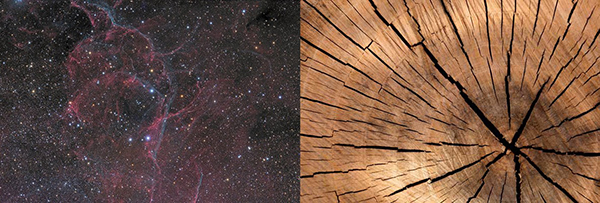Stellar explosions known as supernovae may be behind several anomalous rises in radiocarbon captured in tree rings over the past 40,000 years, according to a recent study that adds mounting evidence to the hypothesis that supernovae can impact Earth's climatology and biota. Nearly all of the time, the light shining from the stars in our sky is benign and dim. But every several thousand years, on average, one of these stars ends its stellar life as a supernova, blazing brighter than our entire galaxy and emitting tremendous amounts of gamma rays and other radiation. Researchers have speculated that these stellar explosions, if close enough to Earth, could degrade Earth's protective ozone layer and alter the climate. These nearby supernovae could even significantly irradiate the planet's surface and kill certain kinds of organisms while spurring potentially harmful mutations in others. Supernovae have thus emerged as a potential triggering event for the rare mass extinctions in Earth's history, during which a large percentage of life forms has inexplicably disappeared from the fossil record. See also: Gamma ray; Mass extinctions; Radiation; Star; Stratospheric ozone; Supernova

Before blaming these dramatic effects on supernovae, however, researchers are still seeking firmer evidence of more minor, more recent, and more easily traceable connections between the cataclysmic demises of distant stars and Earthly occurrences. The new study explores a potential link between relatively recent supernovae, which leave behind characteristic nebulae and stellar remnants such as pulsars, and spikes in radiocarbon levels in tree rings. When gamma rays strike atoms in our atmosphere, the rays can dislodge neutrons that combine with nitrogen atoms. The resulting unstable nitrogen then decays into radiocarbon atoms, or carbon-14 (14C), a radioactive isotope of carbon. Trees regularly take up carbon (in the form of carbon dioxide during photosynthesis), preserving it in their annual bands of growth called tree rings. By measuring the amount of radiocarbon present versus an established baseline, scientists can date certain events, such as droughts and forest fires, that leave telltale marks in tree ring patterns. See also: Carbon; Dating methods; Dendrochronology; Nebula; Radiocarbon dating; Stellar evolution
The new study considered eight supernovae that, based on astronomical observations, have occurred closest to Earth over the last 40,000 years—a timeframe within which radiocarbon dating is considered highly reliable per 14C's half-life. When compared to deeply documented and widely geographically spaced-out records of tree rings over this span, the timing of all eight supernovae corresponded with increased radiocarbon measurements. The unexplained radiocarbon spikes each lasted just a few years, correlating with the expected increase in 14C that a supernova temporarily bathing Earth in gamma rays would produce. One particularly striking example: a star, located just 815 light-years away in the Vela constellation, that detonated as a supernova approximately 13,000 years ago. According to tree-ring data, radiocarbon levels shot up worldwide by almost 3% at this juncture. See also: Constellation; Half-life; Light-year
While the study's results lend support to the overall theory, another potentially confusing or overlapping source of extra gamma-ray radiation is sporadic outbursts from the Sun known as solar flares. Another possible source of error: dating supernovae is inexact, with other estimates placing the Vela event closer to 11,000 years ago. Even so, the study represents another step forward in intertwining the deaths of massive stars located hundreds of trillions of kilometers away with changes here on Earth. See also: Sun





